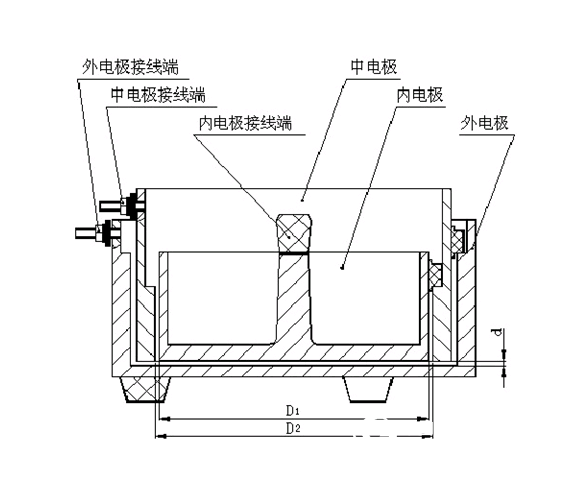It is made according to GB1672-88 standard and is an indispensable special instrument for measuring liquid volume resistivity in chemical, plastic, cable, paint and other industries. It is used together with high resistance meter.

Liquid volume resistivity tester principle
The liquid volume resistivity is calculated as follows:
Volume resistivity (Ω·m)
Rv: volume resistance (Ω)
S: measuring electrode effective area (m2)
Measuring electrode effective diameter (m)
Measuring electrode and ring electrode bilateral spacing (m)
Second, the instructions for use
(1) The high resistance meter shall meet the following requirements:
1. The test voltage range should include: 100V~500V
2. The high resistance measurement range should include: 1 × 106 Ω ~ 1 × 1018 Ω
3. When the resistance is greater than 1012Ω, the measurement error should be less than ±20%, and the resistance should be less than 1012Ω. The measurement error should be less than
±10%.
4. The insulation resistance of the input wiring should be greater than 100 times the input resistance of the instrument.
5. The sample and measuring wire should be well shielded during the test.
6. The instrument should be checked regularly.
(2) Preparation:
1. Take 50ml of the sample to be tested (eg plasticizer).
2. The sample should be treated at a temperature of 23 ± 2 ° C and a relative humidity of 65 ± 5% for more than 2 hours.
(3) Test steps:
1. The test temperature is 23±2°C, the relative humidity is 65±5%, and no external electromagnetic field interferes with the environment.
2. When the test is applied, the voltage applied to the sample is 100V~500V DC voltage, and the voltage grade is selected.
3. Pour the sample into the high voltage electrode so that the liquid surface is just in contact with the lower edge of the ring electrode.
4. Connect the fully discharged sample and electrode to the high resistance meter.
The external electrode (high voltage electrode) is connected to the high voltage output of the high resistance meter.
The inner electrode (measuring electrode) is connected to the measuring end of the high resistance meter.
The middle electrode (ring electrode) is connected to the ground of the high resistance meter.
5. Preheat the instrument for 30 minutes, adjust the instrument after stabilization (zero adjustment), add 1 minute test, read the resistance indication value,
Then, it was discharged for 1 minute and then tested again, and the arithmetic mean of the second was used as the resistance value of the test sample.
(4) Calculation method:
The volume resistivity (pv) is calculated according to equation (1), and the calculation result takes two significant digits.
(5) Notes:
1. The measuring electrode must be placed on a highly insulating backing plate.
2. The measuring electrode should be cleaned before and after the test, especially the support of the three electrodes shall not be subjected to the sample.
Pollution.
Volume surface resistance tester, this instrument can measure both high resistance and micro current. The large-scale integrated circuit of Intel Corporation of the United States is adopted to make the instrument small in size, light in weight and high in accuracy. The digital liquid crystal directly displays the resistance value and current. The measurement range is from 1×104Ω to 1×1018Ω. It is the digital ultra-high resistance measuring instrument with the widest measurement range and the highest accuracy in China. The current measurement range is 2 x 10-4 to 1 x 10-16A. The internal test voltage is adjustable from 10V/50V/100V/250V/500V/1000V. The instrument has high precision, quick display, good stability and convenient reading, and is suitable for measuring the volume and surface resistance of various insulating materials in the shape of rubber, plastic, film, powder, liquid, and solid and paste. In addition to measuring resistance, the instrument can directly measure weak current.
typical application
1, measuring insulation material resistance, volume resistance, surface resistance (rate)
2. Measure the resistance and resistivity of antistatic materials
3. Measuring the system resistance of the movable floor of the computer room
4, measuring the resistance value of anti-static shoes, conductive shoes
5, photodiode dark current measurement
6. Physics, optics and materials research
Welcome to inquire!
Dining Chair,Pp Plastic Chair,Leisure Back Chair,Home Dining Chair
vchomy , https://www.vichenivchomy.com